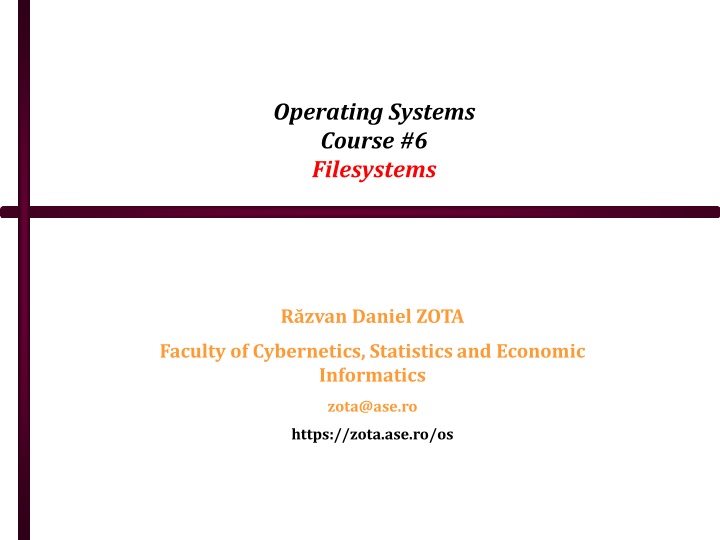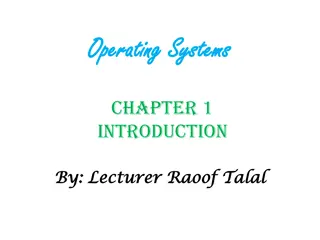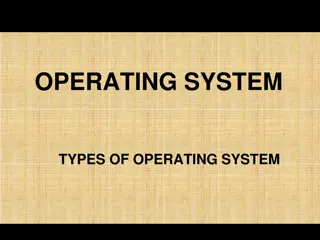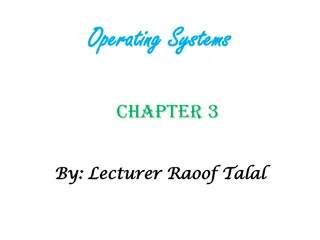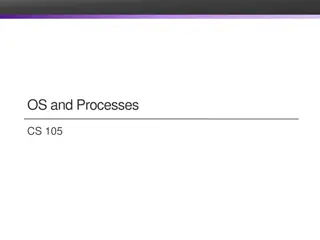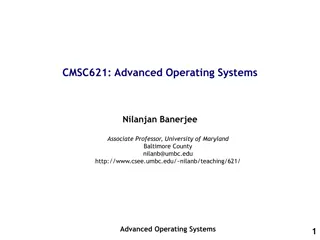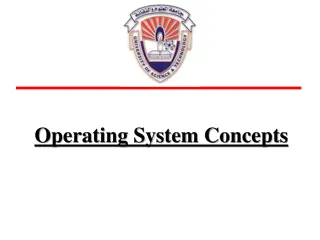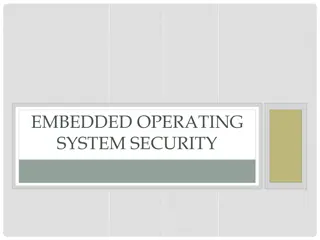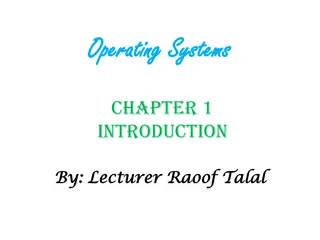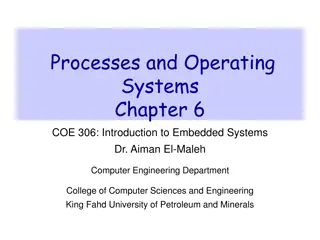Operating Systems
A filesystem is an essential part of an operating system, encompassing directories and data necessary for accessing, locating, and manipulating files. Explore Unix/Linux and Windows file system structures, learn about key directories, and discover supported filesystems like NTFS, FAT, HFS+, Ext, and more.
Download Presentation

Please find below an Image/Link to download the presentation.
The content on the website is provided AS IS for your information and personal use only. It may not be sold, licensed, or shared on other websites without obtaining consent from the author.If you encounter any issues during the download, it is possible that the publisher has removed the file from their server.
You are allowed to download the files provided on this website for personal or commercial use, subject to the condition that they are used lawfully. All files are the property of their respective owners.
The content on the website is provided AS IS for your information and personal use only. It may not be sold, licensed, or shared on other websites without obtaining consent from the author.
E N D
Presentation Transcript
Operating Systems Course #6 Filesystems R zvan Daniel ZOTA Faculty of Cybernetics, Statistics and Economic Informatics zota@ase.ro https://zota.ase.ro/os
Introduction to filesystems What is a filesystem? A filesystem is an integral part of an operating system, directories and all the information needed to access, locate (and recover, if needed) and manipulate them. consisting of files, 2
File system structure Unix/Linux File System Structure Unix Operating System Root Directory Unix Operating System Root Directory / bin dev etc lib tmp var opt usr bin lib man spool K P jdk-1.1 acct cron mail 3Com SCO Skunk97 terminfo uucp 3
File system structure Windows Example: 4
The most important Unix directories /bin UNIX commands /dev Devices directory Files required to boot the system and communicate, and scripts to control the boot process /etc /kernel Contains the kernel and drivers for the kernel /mnt /opt The mount directory; reserved for mounting filesystems locally installed packages and files Files required to start the system and scripts to control the boot process /sbin /shlib Shared libraries /tmp Temporary directory /usr User routines 5
The most important Linux directories /bin Binary (executable) files basic system programs System boot directory. The kernel, module links, system map, and boot manager reside here Devices directory System wide configuration scripts Process directory. Contains information and statistics about running processes and kernel parameters System wide device directory. Contains information and statistics about device and device names Temporary directory More system binaries Miscellaneous binaries local to the particular machine Documentation for installed packages /boot /dev /etc /proc /sys /tmp /usr/bin /usr/local/bin /usr/share/doc 6
OSs and supported filesystems OS Filesystems NTFS, FAT16, FAT32 HFS+ (Hierarchical File System Plus) Ext 2, Ext 3, Ext 4 Windows 7/8/10 Mac OS X Linux NTFS (New Technology File System)- was introduced in Windows NT and at present is major file system for Windows. This is a default file system for disk partitions and the only file system that is supported for disk partitions over 32GB. The file system is quite extensible and supports many file properties, including access control, encryption etc. Each file on NTFS is stored as file descriptor in Master File Table and file content. Master file table contains all information about the file: size, allocation, name etc. FAT12 was used for old floppy disks. FAT16 (or simply FAT) and FAT32 are widely used for flash memory cards and USB flash sticks. It is supported by mobile phones, digital cameras and other portable devices. 7
OSs and supported filesystems HFS+ file system is applied to Apple desktop products, including Mac computers, iPhone, iPod, as well as Apple X Server products. Advanced server products also use Apple Xsan file system, clustered file system derived from StorNext or CentraVision file systems. Ext2, Ext3, Ext4 - 'native' Linux file system. This file system falls under active developments and improvements. Ext3 file system is just an extension to Ext2 that uses transactional file write operations with journal. Ext4 is a further development of Ext3, extended with support of optimized file allocation information (extents) and extended file attributes. This file system is frequently used as 'root' file system for most Linux installations. 8
CDFS and UDF CDFS (CD-ROM File System) represents a relatively simple format defined in 1988 as the CD-ROM standard. Windows implements this standard compatible with ISO 9660 in \Windows\System32\Drivers\Cdfs.sys. CDFS restrictions: The name (for files and directories) < 32 characters The tree structure for subdirectories <= 8 levels UDF (Universal Disk Format) a standard compatible with ISO 13346, offering support for versions 1.02 and 1.5 OSTA (Optical Storage Technology Association) defined in 1995 as a replacement format for CDFS, especially DVD-ROM. The names (for files and directories) <= 255 characters The maximum length for a path = 1023 characters The name of the files can be lower/upper case 9
FAT, FAT16 and FAT32 For many years, the most popular filesystem was FAT (File Allocation Table). There are 3 types of FAT. The first one is the original FAT (FAT12), then appeared FAT16 and FAT32, improved versions for the original FAT. The original FAT was limited from many points of view, being capable to recognize only files up to 8 characters in length. The disk space was inefficient used, so FAT16 was built to support partitions up to 4 GB. But the space on the disk was inefficient used. For example, using a partition of 512 MB, the clusters dimension is 8 KB, meaning that the 1 KB files will occupy 8 KB of space on disk, because we cannot store multiple files in a cluster. In conclusion, we have 7 KB lost. http://www.ntfs.com/hard-disk-basics.htm 10
FAT32 In order to solve the problems of FAT16, FAT 32 was developed, using less dimensions for clusters and supporting partitions up to 2 TB. For example, if we consider a partition of 2.048 MB (2 GB) formatted in FAT16, we will have a FAT table with 65,526 clusters, each cluster consuming 32 KB. The big dimension of the cluster will have a negative impact in using the space on the disk. If we use for this partition the FAT32 system, this will lead to cluster of only 4 KB and an economy of 90% in using the hard disk space. But there is a price for this: we need to have more clusters (instead of 65.526 clusters we will have 524.208 clusters). Moreover, the FAT entries in FAT32 table are on 32 bits, so, as a result, the dimension of the FAT table is 16 times more than in the case of FAT16! 11
FAT16 and FAT32 characteristics Type of FAT FAT16 FAT32 Cluster dimension 32 KB 4 KB Number of FAT entries 65,526 524,208 FAT table dimension ~ 128 KB ~ 2 MB 12
FAT16 and FAT32 characteristics Almost any OS is implementing a disk caching mechanism to keep in memory the disk structures frequently accessed (the FAT table, for example). The caching operation implies using the main memory to store information about disk, avoiding permanently reading from hard disk (very slow comparative with main memory). So, when the FAT table is small (128 KB for FAT16) it is easy to store it in memory, but when the dimension of table grows up, the system is forced to use a big amount of memory for FAT, or not to use memory at all. The maxim number of the FAT32 clusters is 268 million, so with a 4 KB cluster it may offer support for a disk of 1 TB. But in this case the dimension of the FAT table will be over 1 GB! (268 milions multiplied by 4 bytes for each entry in the table). 13
The clusters dimensions for FAT32 The minimum dimension of the partition The maximum dimension of the partition Cluster dimension 4 KB 0.5 GB 8 GB 8 KB 8 GB 16 GB 16 KB 16 GB 32 GB 32 KB 32 GB 64 GB 14
FAT32 characteristics In the following table we may see the dimensions of the FAT table in MB, function of the partition s dimension for different sizes of the clusters. We may see that FAT32 is using clusters of 4 KB until 8 GB partitions, otherwise the memory used to store FAT table would be too big. The entries marked with bold show us what FAT32 Windows will choose for a partition of that size (the FAT table dimension is kept at 8 MB). 15
The FAT32 table dimension Partition dimension 4 KB clusters 8 KB clusters 16 KB clusters 32 KB clusters 8 GB 8 MB 4 MB 2 MB 1 MB 16 GB 16 MB 8 MB 4 MB 2 MB 32 GB 32 MB 16 MB 8 MB 4 MB 64 GB 64 MB 32 MB 16 MB 8 MB 2 TB (2,048 GB) -- 1,024 MB 512 MB 256 MB 16
NTFS New Technology File System Starting with Win 2000, the NTFS file system is the native file system on Windows. NTFS is using 64 bits for index clusters. This capability offers the ability to address volumes up to 16 exabytes. Multiples of bytes SI decimal prefixes Binary usage Name (Symbol) Value 3 10 kilobyte(kB) 10 2 6 20 megabyte (MB) 10 2 9 30 gigabyte(GB) 10 2 12 40 terabyte (TB) 10 2 15 50 petabyte (PB) 10 2 18 60 exabyte (EB) 10 2 21 70 zettabyte (ZB) 10 2 24 80 yottabyte(YB) 10 2 17
NTFS characteristics NTFS characteristics Access control Importance Access rights for individual files or directories It contains records for each file and directory in NTFS; The records regarding NTFS structure and MFT are redundant when the first record is corrupted; Small files (under 1500 bytes) are stored entirely in MFT for a faster access. MFT (Master File Table) NTFS file attributes The file attributes are contained in the MFT record of the file. The list of the file attributes may be particularized for some other systems (Mac, UNIX, Linux) in order to extend the NTFS functionality. Filenames NTFS allows filenames up to 255 characters but it can generate 8+3 names for backward compatibility with FAT/DOS 18
NTFS characteristics POSIX compliance The POSIX compliance enables UNIX apps to access the files stored in NTFS under Windows NT. To do this, NTFS needs some file attributes that are unique to POSIX, like: - Case sensitive filenames; - Hard-links that enable a file to be accessed from different sources; - A time stamp" attribute to identify when a file was last accessed or modified. Macintosh support services enable users accessing files from Macintosh platforms; for Mac users the NT server looks like an AppleShare server. Macintosh access control rights are also supported. If NTFS finds a bad sector on a SCSI disk will automatically move affected files and will mark it as "bad" without user intervention. NTFS is using the cache memory manager for buffer writes on disk within a process called "lazy-write". Alco, it runs a monitoring program for writing on the disk which allows to recover the filesystem (https://docs.microsoft.com/en- us/windows/win32/fileio/file-caching) Macintosh support Hot Fixing Filesystem recovery in case of a crash. 19
Master File Table - NTFS Increased reliability by MFT special design 20
MFT - characteristics The Master File Table was been designed for a quick and safe access to files. The main characteristics of it are: superior performance in finding files on disk(quick find for small files and directories) and great reliability (as a result of redundant characteristics). MFT can serve both objectives very well. First of all, the definition of MFT records enable small files and directories to be included in these records and there is not necessary any access to disk. For big files NTFS uses a hierarchical binary tree structure in order to quick search in bigger directories. The reliability is assured by the link between these redundant characteristics: Redundant master record the mirror record (the copy) of MFT; Redundant files and data segments MFT mirror MFT; Redundant sector boots (the existence of the primary boot sector and dual boot sector its copy). 21
Comparison of NTFS and FAT File Systems https://docs.microsoft.com/en-us/previous- versions/windows/it-pro/windows- vista/cc766145(v=ws.10) (A nice comparison between NTFS, FAT16 and FAT32) 22
Other filesystems Default filesystem on a Linux is ext3 (third extended filesystem) or ext4 More information at: http://en.wikipedia.org/wiki/Ext3 http://en.wikipedia.org/wiki/Ext4 JFS (Journaling FileSystem) - filesystem created by IBM; used on Unix AIX and on Linux versions. A journaling file system is a file system that keeps track of changes not yet committed to the file system's main part by recording the intentions of such changes in a data structure known as a "journal", which is usually a circular log. OCFS2 (Oracle Cluster File System) filesystem created by Oracle for Linux clusters. https://oss.oracle.com/projects/ocfs2/ 23
Which Linux file system should you choose? Read this interesting article: http://www.howtogeek.com/howto/33552/htg-explains- which-linux-file-system-should-you-choose/ 24
Unix/Linux commands about hard disk and partitions df (disk free) used to see the free space on a hard disk df h (human readable format) du (disk usage) used to determine the occupied space by a directory as a number of 512 bytes blocks du k (occupied space in blocks of 1 KB) du k | tail -1 (showing the last line of the listing total no of blocks) 25
Backup commands, file archiving-Linux File archiving is used when one or more files need to be transmitted or stored as efficiently as possible. There are two aspects to this: Archiving Combining multiple files into one, which eliminates the overhead in individual files and makes it easier to transmit Compressing Making the files smaller by removing redundant information You can archive multiple files into a single archive and then compress it, or you can compress an individual file. The former is still referred to as archiving, while the latter is just called compression. When you take an archive, decompress it and extract one or more files, you are un-archiving it. 26
Compressing files Compressing files makes them smaller by removing duplication from a file and storing it such that the file can be restored. When talking about compression, there are two types: Lossless: No information is removed from the file. Compressing a file and decompressing it leaves something identical to the original. Lossy: Information might be removed from the file as it is compressed so that uncompressing a file will result in a file that is slightly different than the original. For instance, an image with two subtly different shades of green might be made smaller by treating those two shades as the same. Often, the eye can t pick out the difference anyway. 27
Compressing files From lossy compression often benefits media because the results are smaller files in size and people can t tell the difference between the original and the version with the changed data. For things that must remain untouched (documents, logs, and software) you may need lossless compression. Most image formats, such as GIF (Graphics Interchange Format ), PNG (Portable Network Graphics), and JPEG (Joint Photographic Experts Group), implement some kind of lossy compression. 28
Tar archiving command tar (tape archive) standard for all Unix versions General syntax: tar function [modifier] destination_file(s) | directories tar functions: c (create) in order to create an archive t (table of contents) in order to view the content table of a tar file x (extract) used to extract files from archive Modifiers (a few examples): f (filename) the tar file will be created; otherwise it is picked the device specified by the medium variable TAPE, if it is set; if not, the default value from /etc/default/tar is used. v (verbose) together with the t function gives extra information about tar file 29
Archiving and compression commands tar examples: - tar -cvf dir2backup.tar dir2 (it creates the tar archive for dir2 directory) - tar -cvf ex.tar f1 f2 f3 (it creates the tar archive with files f1, f2, f3) -tar -tvf ex.tar (to view the contents of an archive) -tar -xvf myfile.tar (extraction from the tar file) -tar zcvf mybackups/udev.tar.gz /etc/udev (To create a tar file that is compressed use -z option: The -z option makes use of the gzip utility to perform compression) -tar -czf a_files.tar.gz a* -To add a file to an existing archive, use the -r option to the tar command: -tar -rvf udev.tar /etc/hosts Combining file archiving and compression with the jar (Java archive) command: jar cvf home.jar * 30
Compression commands- UNIX/Linux GNU compression program: gzip The gzip creates a smaller file with .gz extension.For example, the command: gzip student the student file will be transformed into a compressed file called student.gz gzip l student.gz will offer information about the compression ratio gunzip (gzip d) is used for decompression Note: We may find on Linux the zip and unzip commands, similar with Windows versions. In this case we may work with zip files compressed on Windows. zip home.zip * - will create an archive called home.zip from all files in the present working directory The command: unzip labs.zip will extract all the files from the archive to the current directory unzip l labs.zip will list the files in the .zip archives 31
Compression commands- UNIX/Linux Other compression commands are bzip2 and xz: The bzip2 command uses Burrows-Wheeler compression algorithm which will compress files smaller than gzip at the expense of more CPU time. The resulted files have a .bz2 extension, instead of .gz extension. xz command: it s similar with gzip and it uses the Lempel-Ziv-Markov (LZMA) algorithm. It can provide a better compression ratio than bzip2. The files compressed with the xz command use .xz extension. In order to uncompress the .xz file, unxz command can be used (or xz d). 32
